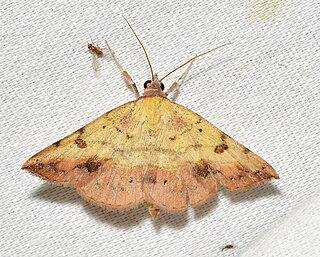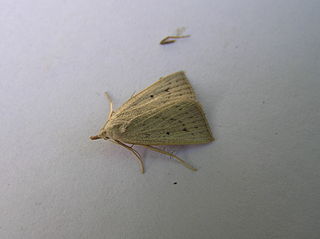
The Noctuidae, commonly known as owlet moths, cutworms or armyworms, are a family of moths. They are considered the most controversial family in the superfamily Noctuoidea because many of the clades are constantly changing, along with the other families of the Noctuoidea. It was considered the largest family in Lepidoptera for a long time, but after regrouping Lymantriinae, Catocalinae and Calpinae within the family Erebidae, the latter holds this title now. Currently, Noctuidae is the second largest family in Noctuoidea, with about 1,089 genera and 11,772 species. This classification is still contingent, as more changes continue to appear between Noctuidae and Erebidae.

The Arctiinae are a large and diverse subfamily of moths with around 11,000 species found all over the world, including 6,000 neotropical species. This subfamily includes the groups commonly known as tiger moths, which usually have bright colours, footmen, which are usually much drabber, lichen moths, and wasp moths. Many species have "hairy" caterpillars that are popularly known as woolly bears or woolly worms. The scientific name Arctiinae refers to this hairiness. Some species within the Arctiinae have the word "tussock"' in their common names because they have been misidentified as members of the Lymantriinae subfamily based on the characteristics of the larvae.

The Lymantriinae are a subfamily of moths of the family Erebidae. The taxon was erected by George Hampson in 1893.

The Calpinae are a subfamily of moths in the family Erebidae described by Jean Baptiste Boisduval in 1840. This subfamily includes many species of moths that have a pointed and barbed proboscis adapted to piercing the skins of fruit to feed on juice, and in the case of the several Calyptra species of vampire moths, to piercing the skins of mammals to feed on blood. The subfamily contains some large moths with wingspans longer than 5 cm (2 in).

The Herminiinae are a subfamily of moths in the family Erebidae. The members of the subfamily are called litter moths because the caterpillars of most members feed on dead leaves of plants, though others feed on living leaves, and/or the mushrooms of fungi as in the case of genus Idia.

Idia is a genus of litter moths of the family Erebidae first described by Jacob Hübner in 1813.
Mursa is a genus of moths of the family Erebidae.

Palthis is a genus of litter moths of the family Erebidae. The genus was erected by Jacob Hübner in 1825.

Zanclognatha is a genus of litter moths of the family Erebidae. The genus was erected by Julius Lederer in 1857.
Glympis is a genus of moths of the family Erebidae. The genus was erected by Francis Walker in 1859.

Hemeroplanis is a genus of moths of the family Erebidae. The genus was erected by Jacob Hübner in 1818.

Macrochilo is a genus of litter moths of the family Erebidae. The genus was erected by Jacob Hübner in 1825.

Metalectra is a genus of moths of the family Erebidae described by Jacob Hübner in 1823.

Asota is a genus of moths in the family Erebidae first described by Jacob Hübner in 1819. Species are widely distributed throughout Africa, India, Sri Lanka, Myanmar, the Malayan region and tropical parts of the Australian region.

Asota speciosa, the specious tiger, formerly Aganais speciosa, is a moth of the subfamily Aganainae, now regarded as being within the family Erebidae. Formerly it was regarded variously as a member of the Arctiidae, the Hypsidae, and subsequently the family Aganaidae, which was formerly regarded as a family by some authorities. The species is widespread in sub-Saharan Africa, such as in Sierra Leone, Togo, Nigeria, Cameroon, Mozambique and South Africa.

The Erebidae are a family of moths in the superfamily Noctuoidea. The family is among the largest families of moths by species count and contains a wide variety of well-known macromoth groups. The family includes the underwings (Catocala); litter moths (Herminiinae); tiger, lichen, and wasp moths (Arctiinae); tussock moths (Lymantriinae), including the arctic woolly bear moth ; piercing moths ; micronoctuoid moths (Micronoctuini); snout moths (Hypeninae); and zales, though many of these common names can also refer to moths outside the Erebidae. Some of the erebid moths are called owlets.

The Hypenodinae are a subfamily of moths in the family Erebidae. Adult moths of most species of this subfamily lack small, simple eyes near the large, compound eyes and have quadrifine (four-veined) hindwing cells. The micronoctuid moths are an exception because they possess simple eyes and bifine (two-veined) hindwing cells.

Eulepidotinae is a subfamily of moths in the family Erebidae. Adult males in the subfamily have midtibial tufts of hairs. Adult females have the ostial opening located between the seventh and eighth abdominal sternites instead of located anteriorly on the seventh sternite.

The Rivulinae are a subfamily of moths in the family Erebidae described by Augustus Radcliffe Grote in 1895. Caterpillars in the subfamily typically have long, barbed hairs and have full prolegs on abdominal segments 3 through 6. The adults have a unique microsculpturing proboscis.

The Pangraptinae are a subfamily of moths in the family Erebidae.


















